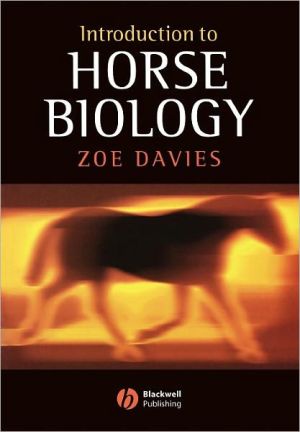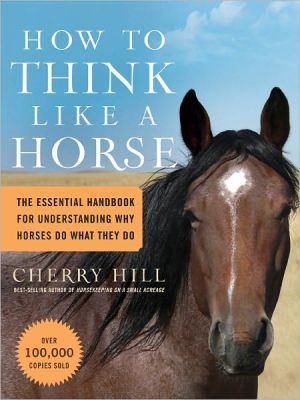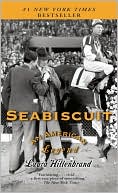Introduction to Horse Biology
Many students have only a limited knowledge of biology before starting a variety of equine courses, from BHS stages to National Certificate and Diploma and HND/degree. Introduction to Horse Biology provides all the information students of equine subjects require, particularly those without a GCSE or A level in biology.\ This book will be invaluable to all students of equine subjects including First Diploma, National Diploma, National Certificate, Higher National Diploma and Higher National...
Search in google:
Many students have little or no knowledge of biology before they enrol for a variety of horse studies courses, from BHS National Certificate and Diploma to HND and degree. This new textbook sets out all the basic knowledge they need for this essential core subject. They cannot progress without it. Doody Review Services Reviewer:Jonathan Hale Foreman, DVM, MS(University of Illinois College of Veterinary Medicine)Description:This introductory-level textbook on the biology of the horse presents its information in 15 chapters, 5 appendixes, a glossary, and an index. The appendixes provide unique, sometimes hard-to-find, information for students such as anatomical terms and metric conversion tables. There are no references cited either in the text or summarized at the end of the book.Purpose:The purpose is to provide basic information on the biology of the horse "required by all students of equine subjects, particularly those without a standard qualification in biology." The book meets this purpose while providing basic equine information for secondary school or introductory college-level students, as well as those enrolled in more specific equine training programs such as veterinary technicians, animal scientists, and horse husbandry programs.Audience:The intended audience includes students pursuing a career or training in most any equine field, without a strong background in biology or physiology. The book will prove valuable to younger audiences aspiring eventually to equine fields, such as 4-H students or Pony Club members. The author is a well-respected lecturer in equine science.Features:The introductory chapter provides a brief overview of equine evolution, modern behavior, taxonomy, basic cellular biology, and nutrition. Two chapters on cellular anatomy and physiology are then followed by a series of chapters on various body systems. The last three chapters cover pathogens, genetics, and aging by teeth anatomy. The text is richly illustrated with black-and-white photographs, line drawings, and charts where appropriate. More advanced students may be disappointed at the basic nature of some of the introductory chapters, but the subsequent systems approach will still prove useful to all students of equine science.Assessment:This is a valuable addition to the field of equine science, and will prove useful for basic students in many formal or informal studies of the horse. More advanced texts are available, but this might be the first that summarizes so much good information about so many aspects of equine biology in a basic form in one book.
1The living horse - some basic principles12Cells and tissues173Chemistry of life274The digestive system445The excretory system546The musculoskeletal system637The circulation848The skin989The respiratory system10710The nervous system11711The endocrine system13312Reproduction13913Disease-causing organisms15514Genetics and heredity16915Teeth and estimating age186AppThe nitrogen cycle202AppPoints of the horse203
\ Reviewer: Jonathan Hale Foreman, DVM, MS(University of Illinois College of Veterinary Medicine)\ Description: This introductory-level textbook on the biology of the horse presents its information in 15 chapters, 5 appendixes, a glossary, and an index. The appendixes provide unique, sometimes hard-to-find, information for students such as anatomical terms and metric conversion tables. There are no references cited either in the text or summarized at the end of the book.\ Purpose: The purpose is to provide basic information on the biology of the horse "required by all students of equine subjects, particularly those without a standard qualification in biology." The book meets this purpose while providing basic equine information for secondary school or introductory college-level students, as well as those enrolled in more specific equine training programs such as veterinary technicians, animal scientists, and horse husbandry programs.\ Audience: The intended audience includes students pursuing a career or training in most any equine field, without a strong background in biology or physiology. The book will prove valuable to younger audiences aspiring eventually to equine fields, such as 4-H students or Pony Club members. The author is a well-respected lecturer in equine science.\ Features: The introductory chapter provides a brief overview of equine evolution, modern behavior, taxonomy, basic cellular biology, and nutrition. Two chapters on cellular anatomy and physiology are then followed by a series of chapters on various body systems. The last three chapters cover pathogens, genetics, and aging by teeth anatomy. The text is richly illustrated with black-and-white photographs, line drawings, and charts where appropriate. More advanced students may be disappointed at the basic nature of some of the introductory chapters, but the subsequent systems approach will still prove useful to all students of equine science.\ Assessment: This is a valuable addition to the field of equine science, and will prove useful for basic students in many formal or informal studies of the horse. More advanced texts are available, but this might be the first that summarizes so much good information about so many aspects of equine biology in a basic form in one book.\ \ \ \ \ From the Publisher'[Puts] scientific information into a form that does not require previous training in biology to follow and understand.' The Journal of Equine Studies Vol 2 No 2\ 'This book aims to supply the student of equine studies with all the information they need, including basic microbiology, genetics and physiology. It is aimed particularly at those doing a (UK) First Diploma, National Diploma, National Certificate, Higher National Diploma, and Advanced National Certificate, and all students studying for BHS or other equine-related examinations.'\ www.cabi.org\ \ \ \ 3 Stars from Doody\ \








